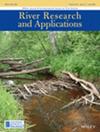景观对美国东南部溪流热敏感性的影响及预测的空间变异性
IF 1.9
4区 环境科学与生态学
Q4 ENVIRONMENTAL SCIENCES
引用次数: 0
摘要
气候变化导致的水温升高对冷水生物构成了重大威胁。然而,由于地表与地下水之间的相互作用以及溪流和流域的特点,变暖的速度在空间上并不一致。抗变暖能力最强的冷水栖息地可作为热庇护所,确定其位置对区域水生生物保护规划至关重要。我们量化了美国阿巴拉契亚山脉南部和中部地区近 1000 公里范围内为溪鳟(Salvelinus fontinalis)提供当前和潜在栖息地的 203 条溪流的热敏感性,并利用国家水文地理数据集(National Hydrography Dataset)中的景观变量描述了这些溪流的空间变异性。利用贝叶斯框架,我们计算了配对周平均气温与溪流温度之间的对数函数的最大斜率,以此作为溪流热敏性指数。溪流在热敏感性方面存在很大差异,那些具有较强水温抵抗力的溪流(即热避难所)始终以南纬度和地下水输入为特征。通过主成分分析得出的景观变量解释了热敏性变化的 16%,这表明现有的景观变量在解释空间热异质性方面略显成功。利用我们的模型和空间插值法,我们预测了研究区域内 8695 个可能适合溪鳟生长的河段的热敏感性。据推测,由于海拔较高,热庇护所向南较为常见,但在其他地方,热庇护所也以更精细的空间尺度聚集。我们的分析为在气候变暖的世界中优先保护和恢复这种本地鲑鱼和其他依赖冷水栖息地的水生生物的栖息地提供了信息。本文章由计算机程序翻译,如有差异,请以英文原文为准。
Landscape influences on thermal sensitivity and predicted spatial variability among brook trout streams in the southeastern USA
Warming water temperatures as a result of climate change pose a major threat to coldwater organisms. However, the rate of warming is not spatially uniform due to surface‐ground‐water interactions and stream and watershed characteristics. Coldwater habitats that are most resistant to warming serve as thermal refugia and identifying their locations is critical to regional aquatic conservation planning. We quantified the thermal sensitivity of 203 streams providing current and potential habitat for brook trout (Salvelinus fontinalis ) across nearly 1000 linear km of their native range in the southern and central Appalachian Mountains region, USA, and characterized their spatial variability with landscape variables available in the National Hydrography Dataset. Using the Bayesian framework, we calculated the maximum slope of the logistic function relating paired weekly mean air temperature and stream temperature as an index of stream thermal sensitivity. Streams differed greatly in thermal sensitivity and those with more resistant water temperature regimes (i.e., thermal refugia) were consistently characterized by southerly latitudes and groundwater input. Landscape variables derived from a principal component analysis explained 16% of the variation in thermal sensitivity, indicating that the existing landscape variables were modestly successful in explaining spatial thermal heterogeneity. Using our model and spatial interpolation, we predicted thermal sensitivity at 8695 stream segments potentially suitable for brook trout in the study region. Thermal refugia were more common southward presumably due to higher elevations, but elsewhere they were also clustered at finer spatial scales. Our analysis informs prioritizing habitat conservation and restoration of this native salmonid and other aquatic organisms that depend on coldwater habitats in a warming world.
求助全文
通过发布文献求助,成功后即可免费获取论文全文。
去求助
来源期刊

River Research and Applications
环境科学-环境科学
CiteScore
4.60
自引率
9.10%
发文量
158
审稿时长
6 months
期刊介绍:
River Research and Applications , previously published as Regulated Rivers: Research and Management (1987-2001), is an international journal dedicated to the promotion of basic and applied scientific research on rivers. The journal publishes original scientific and technical papers on biological, ecological, geomorphological, hydrological, engineering and geographical aspects related to rivers in both the developed and developing world. Papers showing how basic studies and new science can be of use in applied problems associated with river management, regulation and restoration are encouraged as is interdisciplinary research concerned directly or indirectly with river management problems.
 求助内容:
求助内容: 应助结果提醒方式:
应助结果提醒方式:


